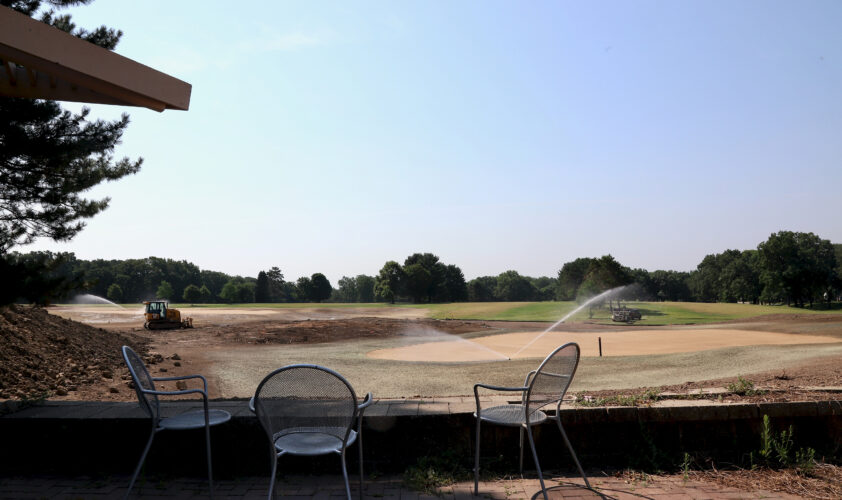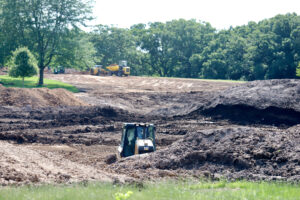On a sunny summer day in Madison, Wisconsin, the reimagining of Glenway Golf Course was feverishly under- way. Instead of golf carts zipping over the hills or walkers with pushcarts in twos and fours, big machines and their operators were pushing dirt, shaping greens and otherwise reinventing what had long been a popular but modest nine-hole layout in a residential neighborhood on the city’s west side.
When the laborers have finished and grass grows in, Glenway will still be a nine- hole golf course, but hardly the one it was before work began. Greens will be larger and boast more personality, fairways will be wider and firmer. And Glenway will be much more than a golf course, as well, transforming into a multi-use playground for golfers and non-golfers alike, with hiking trails, a putting course that will be open and free to the public — even some open space for community events.
And there will be another rarity for a nine-hole public course — a caddie program. The plan calls for caddies whose fees would be paid not by the golfers who hire them but the Western Golf Association, which runs the Evans Scholars program of full-ride caddie scholarships.
That the project was a gift to the city of Madison from Michael Keiser and his wife, Jocelyn, was something of a surprise on two levels. One, the initial cost was valued at about $750,000, which is not the kind of donation cities are handed every day.
And two, Keiser isn’t known for modest nine-hole courses. He runs the celebrat- ed Sand Valley Golf Resort near Nekoosa, Wisconsin, which his father, Mike Keiser, created after similarly succeeding with Bandon Dunes Golf Resort in Oregon. Both are magnets for high-end golfers and bucket-list buddy trippers who are eager to pay big bucks to take on brawny 18-hole layouts that have won golf’s highest honors for design and challenges.
But Keiser, who with Jocelyn now live in Madison, said he saw in little Glenway a golf course that was neither long nor overly difficult and one that could be enjoyed by players of all skill levels.
“Honestly, that length of golf course with great design is what golf needs more of,” he said in presenting his plan last spring. The Madison Parks Commission eagerly embraced the gift, and to the surprise of more than a few — Madison is known for enjoying years of debate and political wrangling over seemingly routine matters — the Common Council unanimously approved the project. Supporters said the emphasis on a mixed-use park was in keeping with recommendations of a golf course task force created to deal with long-term deficits in the city’s golf operation. Construction began in May with the removal of some trees and plans call for play to begin at the new Glenway in 2022.
Keiser pulled out all the stops in assembling a murderers’ row of course designers and architects, including some who had helped make Sand Valley a golf destination. They included Craig Haltom, a course designer who had discovered the land where Sand Valley was built; Brian Schneider of Renaissance Golf Design, a UW-Madison graduate who is now working on the Lido course at Sand Valley; and Sara Mess, a former college golfer who worked for architect Tom Doak before becoming a high school golf coach near Madison.
Others consulting on the plan included Jay Blasi, who grew up in the Glenway neighborhood and now works for Robert Trent Jones II golf course architects; Andy North, the two-time U.S. Open champion from Madison; and Andy Staples, a Milwaukee native who is now a course designer. There was also a landscape design team to oversee prairie grass restoration, along with consulting agronomists and a native plant expert. The plan calls for expanding already large swaths of natural area to reduce both irriga- tion and chemical inputs.
By early July, workers had already seeded the first of the nine new greens and work was proceeding on schedule.
“It’s exceeding my expectations,” Keiser said. “The architectural team is a doing a great job. They’re building new features and building really interesting golf holes that will be fun to play.
“It’s a nice variety (of green styles). I feel good that we achieved nine different but fun greens.”
Keiser makes no bones about borrowing from other courses to reimagine Glenway, including the birthplace of the game.
“In terms of the mission of ecology, golf, mixed use, in that case it’s similar to Sand Valley,” he said earlier in describing the plan. But in terms of the redesign of greens and other features, “St Andrews is the model architecturally. We’re trying to draw inspiration from a lot of places but at the end of the day we want it to have a (feeling) all it’s own, and that’s Glenway.”
In addition to all new greens, the work will include a new set of forward tees for youths and high-handicap players, and wider fairways and approaches to offer more options off the tee and a greater variety of shots into the greens. Keiser told city officials that while it sounds paradoxical, the course should be more challenging for the lower handicap player while more friendly for the high-handicappers.
“We think we can make it more enjoyable for both … by increasing the variety,” he said.
The project has grown a bit since work began. Keiser brought in a nationally renowned landscape designer to come up with ways to make the course more appealing for motorists passing by and to partially screen the large putting green that will sit prominently in front of the course. Keiser hopes the free putting green might entice non-golfers to try their hand, and perhaps lure them to try golf in the future. In addi- tion, there will be improvements to the small clubhouse and a renovation of a nearby patio area. Those changes increased the cost of his gift but he declined to say by how much.
The end result will be a new Glenway Golf Course, but even those who know it well might need to get reintroduced.
It’s the same routing,” Keiser said. “I think it will be unique to have the same routing in a different golf course.”
Both Keiser and city golf officials said the mixed-use approach could serve as a model for other courses and other cities. Keiser said he hasn’t heard from anyone yet who wants to copy the concept, but he didn’t expect to yet.
“I think that will come after it opens and we continue to get more attention, when we invite people to come out and play it. I think people need to see it. The proof’s in the seeing.
“Glenway is a unique property and now it will have a unique golf course on it.”
Visit cityofmadison.com for more information.


 ';
';
 ';
';
 ';
';
 ';
';